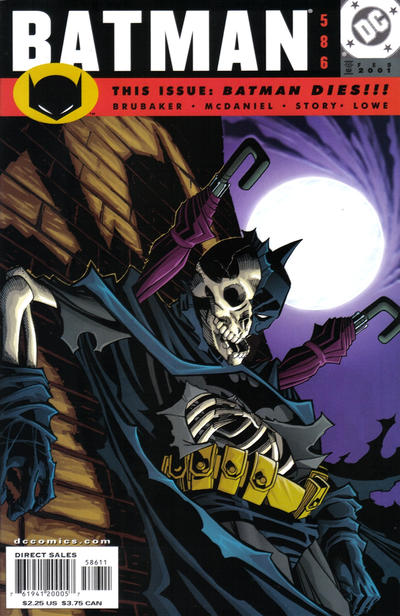In November 2000, the ‘Next Issue’ blurbs in the Batman family of comics announced that something big was about to go down…
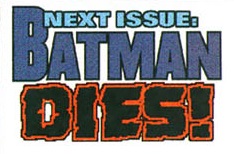 Batman #585
Batman #585
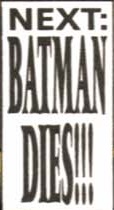 Catwoman (v2) #88
Catwoman (v2) #88
 Robin (v4) #84
Robin (v4) #84
The premise of a story in which the Dark Knight seemingly kicks the bucket is hardly unique (there is even a whole collection devoted to this subgenre). Still, some of you may find it odd that this event remains relatively unnoticed, especially in comparison with the much-publicized Batman deaths written by Grant Morrison less than a decade later (in Batman R.I.P. and Final Crisis). The reason for this is that the blurbs’ promise was extremely misleading: rather than a crossover in which Batman met his demise, the following month DC delivered a set of unconnected issues focusing on different members of the rogues’ gallery, with many of them fantasizing about killing the Caped Crusader.
Even if it was just a cynical stunt, this gimmick allowed creators to present the world as viewed through the rogues’ distorted eyes. They could therefore shift each series’ gaze, taking the side of the foes rather than that of the heroes, and even play intertextual games by providing alternative views on the events from previous comics. As a result, they actually gave us some very cool tales…
Sadly, Batman #586 wasn’t one them. It’s readable, for sure, but very light on ideas… This fantasy about the Penguin’s rather pedestrian plot to kill Batman has a fairly decompressed approach – the whole thing is basically an extended action scene and, even though it’s rendered by Scott McDaniel with his usual gusto and dynamism, there isn’t anything particularly original about it. The only clever twist comes near the end, but it isn’t enough to make up for either the lacklustre lead-up or the uninspired final revelation. I find this a shame, really, since writer Ed Brubaker has proven that he can do alternative history/speculative tales with interesting nuances, for Batman (Gotham Adventures #33) as well as for other superheroes (What If Aunt May Had Died Instead of Uncle Ben?), but here he wasn’t at the top of his game.
Chuck Dixon took greater advantage of the ‘Batman Dies!!!’ gimmick, penning a couple of insightful issues about the psychologies of an A-list villain, the Joker (Robin #85), and a Z-list one, Nite-Wing (Nightwing #51). (He also wrote one about Bane, ‘The Suitor’ (Birds of Prey #26), but it’s a run-of-the-mill yarn that is as much about characterization as about deftly setting up plot points for future arcs, something that Dixon can pretty much do with his eyes closed.)
The Joker tale, ‘Fool’s Errand,’ is loads of fun, with the villain, locked up in Arkham Asylum, recounting his history with the Boy Wonder throughout the years. The result is amusing not just because the Joker only knows one side of his previous encounters with Robin, but also because the way he puts together the missing bits is both absurd and intelligent, which is my favorite take on the Clown Prince of Crime. Thus, we get to revisit older comics – such as A Death in the Family and Joker’s Wild – with a fresh eye. (There are even nods to out-of-continuity Silver Age stories, explained by the fact that we are looking at the delusions of a madman.)
Plus, the art team of Pete Woods, Jesse Delperdang, and Noelle Giddings does justice to Dixon’s script by finding visually inventive ways to convey the Joker’s warped mind:

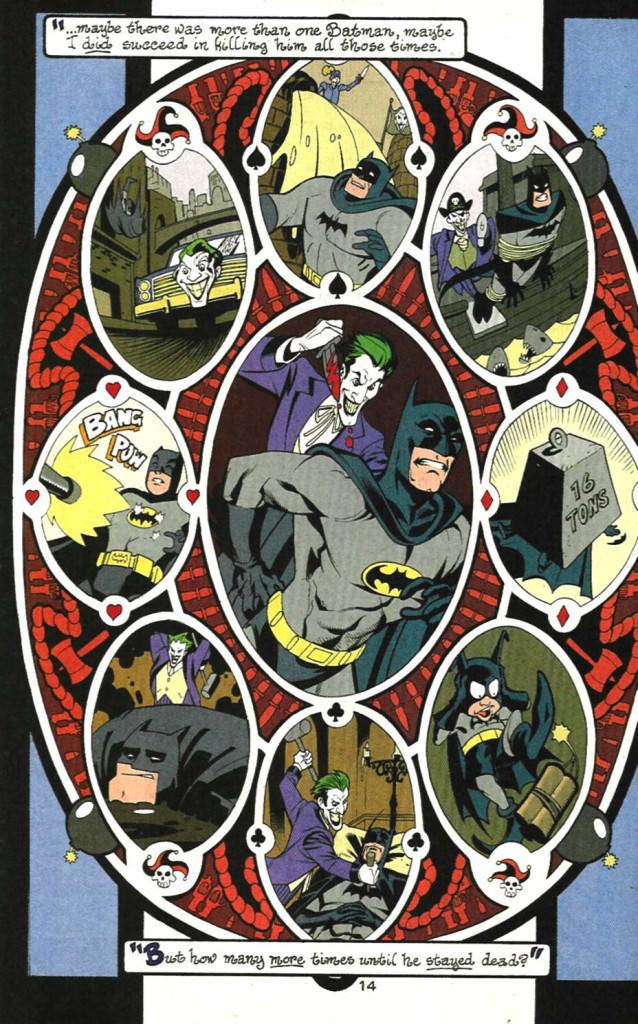 Robin (v4) #85
Robin (v4) #85
(As you can see above, letterer Willie Schubert also totally got into the looney spirit of things!)
Technically, Nightwing’s contribution to the ‘Batman Dies!!!’ event is ‘Modern Romance’ (issue #52), which Chuck Dixon wrote from the point of view of Catwoman, even including an early fantasy sequence (with lovely Greg Land art) in which she kills the Dark Knight. However, the previous issue – about Tad Ryerstad, the confused vigilante who briefly went by the name of “Nite-Wing”– is the one that best captures the event’s potential.
On the surface, ‘Tad’ appears to be a variation of the ‘Fool’s Errand’ formula, giving us a glimpse into the psyche of a recurring foe of Nightwing as he reminisces while locked up in a Blackgate prison cell. Yet Dixon ultimately does something quite different here, revising our perspective in much more drastic terms. Tad’s character was initially mostly played for laughs, albeit of a darker breed, in line with the overall tone of Dixon’s Nightwing run. In this issue, though, he comes across as a decidedly tragic figure, his early childhood an amalgamation of white trash imagery, his conviction that he’s a hero as misguided as Travis Bickle’s…
If the Joker’s schizophrenia served as a pretext for surrealism, Tad’s sociopathic disposition informs a grittier tale, one where the violence of the real world is contrasted with the typically escapist narratives of superhero comics:
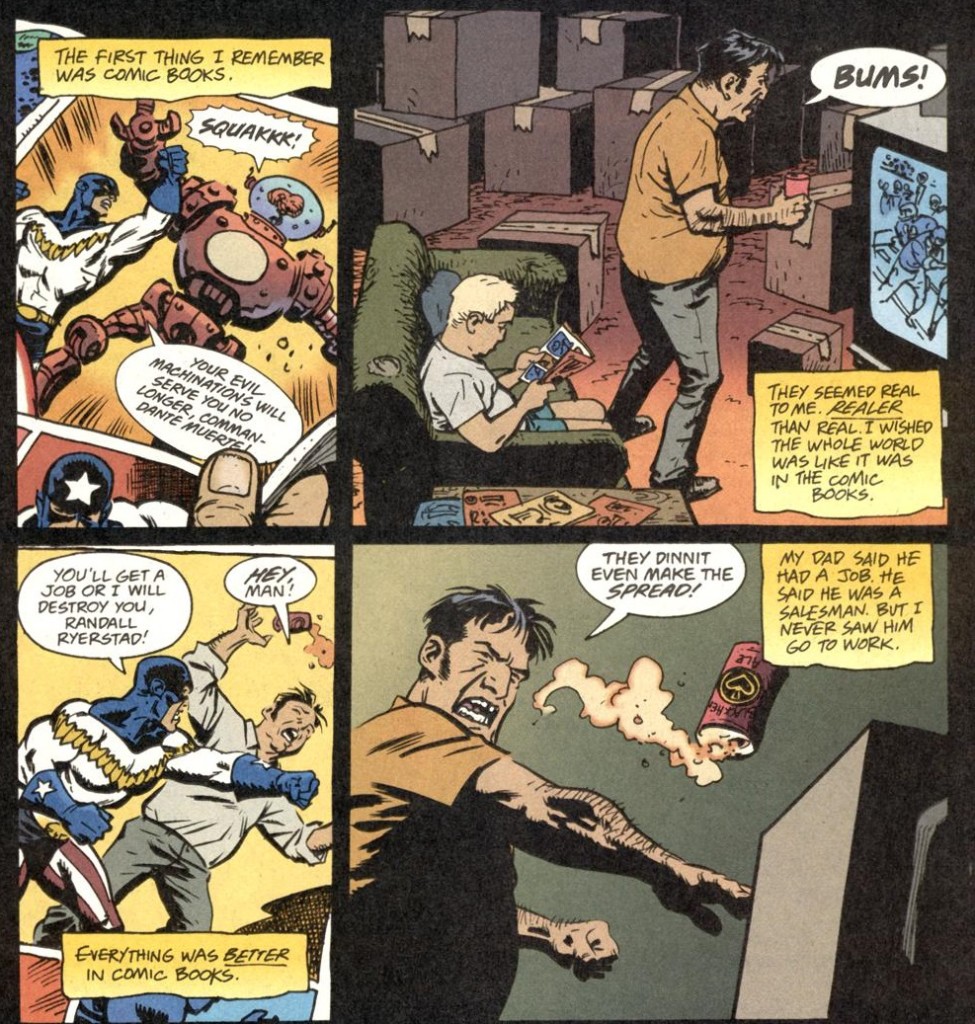 Nightwing #51
Nightwing #51
Let me rephrase: the contrast isn’t really between escapist fiction and reality, since, at the end of the day, the ‘reality’ presented in the comic is itself part of a superhero narrative… in fact, this kind of ‘realism’ has its own tradition in the genre, with the most renown example being 1986’s Watchmen. Tad, as presented in this story, may think of himself as having a more realistic understanding of the world, but he’s actually the representative of a type of fiction – he’s a less successful version of Watchmen’s Rorschach, he’s the flip-side of the way the Punisher is usually depicted (including by Dixon himself).
Guest artist Kieron Dwyer and colorist Patricia Mulvihill drive the point home in this brutal scene:
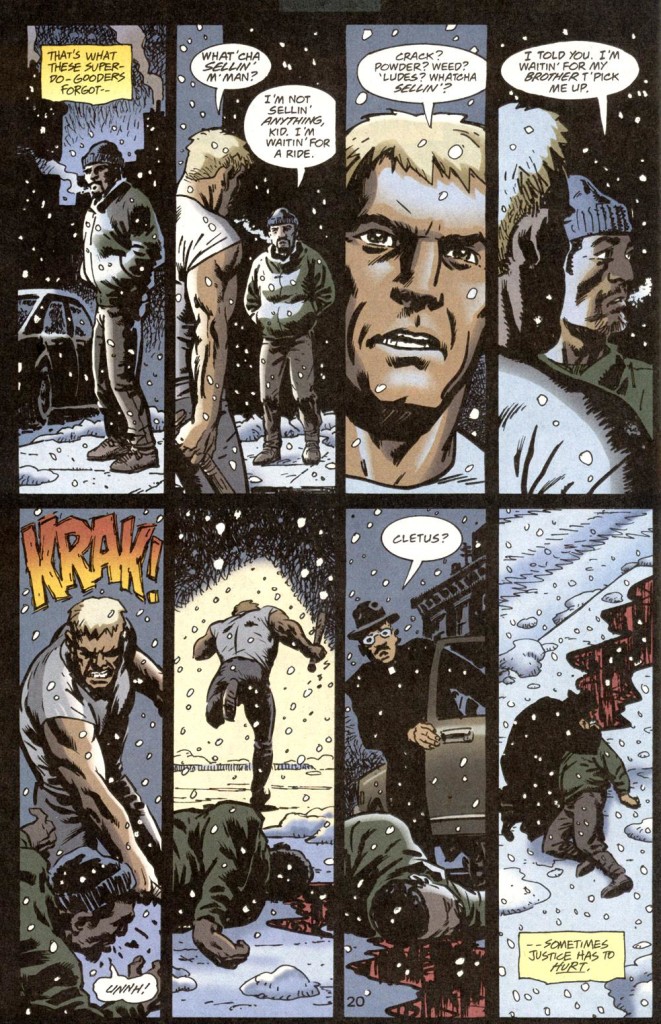 Nightwing #51
Nightwing #51
Catwoman’s ‘Always Leave ’em Laughing’ has a couple of metafictional levels as well. Bronwyn Carlton’s approach to the ‘Batman Dies!!!’ gimmick consists of having Harley Quinn pitch a television show about Catwoman to a group of TV producers. On one level, Quinn’s ideas are illustrated through sequences drawn in the style of Bruce Timm’s animated series (Staz Johnson and Craig Rousseau are listed as pencillers – based on their other works, I’m guessing Johnson drew the ‘real world’ stuff and Rousseau did the pitched material). On another level, Carlton uses the producers’ notes to jokingly comment on previous comics, questioning continuity gaps (‘Oka-aa-ay, right, okay, then – we lose the sister.’) and looking back on the tastelessness of Selina Kyle’s post-Crisis origin (‘It’s much too dark!’). The final product is an entertaining issue all around, even if it doesn’t even bother to justify the promise that Batman was going to die!
The best use of meta-narrative, however, took place on the pages of Detective Comics, where an art therapy program served as a pretext to depict Two-Face’s fantasies in mesmerizingly strange terms:

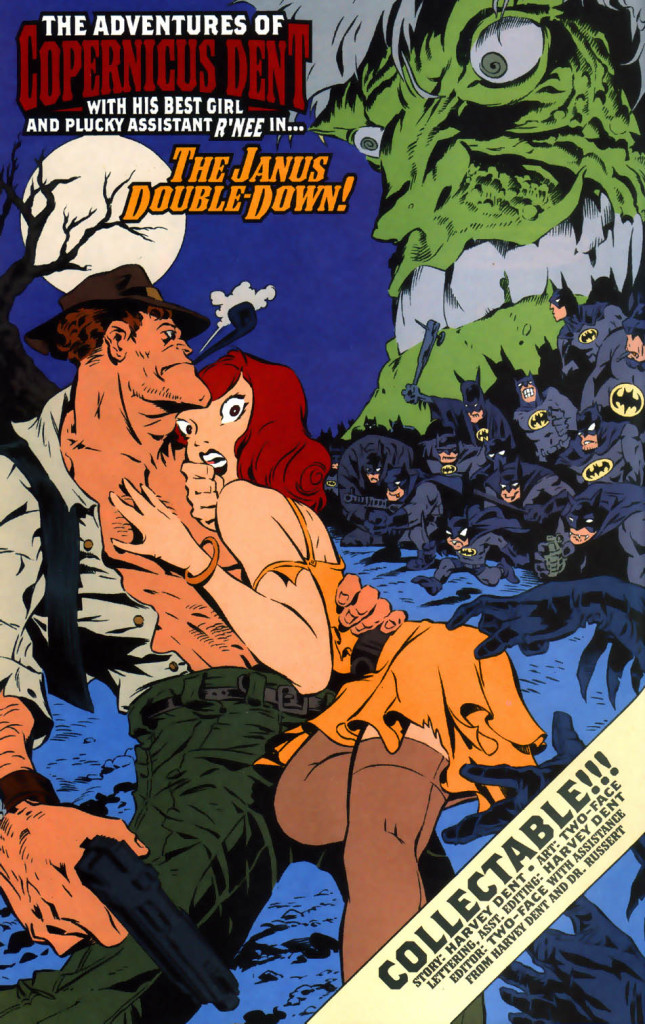 Detective Comics #753
Detective Comics #753
Greg Rucka clearly had a blast writing this one. The comic-within-a-comic hilariously channels Two-Face’s infatuation with Renée Montoya (a long-running subplot in Rucka’s work) into a two-fisted (of course) pulpy adventure where Harvey Dent fights himself, the repetitive storyline reflecting his obsession with doubling and duality. That said, the ending is actually a bit touching if you take into account that it reveals not just Harvey’s sense of inadequacy (‘He only wanted the world to change for him.’) but also his own tragic awareness of it (since he is the one writing about it).
What sells the whole thing, though, is the exuberant art. The first and last pages are consistent with the previous issues in this run, from Brad Rader’s restrained pencils and John Lowe’s firm inks to Wildstrorm FX’s minimalistic colors. In turn, the middle section feels like something from another world: it opens with what appears to be a crude homage to Bernie Wrightson’s work on Swamp Thing, but it soon adopts a more Mad-like cartoon style, quite suited to the material’s whacky tone. Steve Mannion’s exaggerated pencils are inked by Hilary Barta, a perfect choice for this kind of stuff (as proven by his stint on Splash Brannigan).
In the end, we get a comic in which sharp lines and a melancholic mood temporarily give way to wild designs and riotous fantasy before returning to a dark version of normality. I can’t think of a neater embodiment of Two-Face’s inner self!

